Origins of the Chinese Hegemony (2012-2018)[]
From 2012 to 2018, China fell into complete disarray; secessionist movements in Tibet, Hong Kong and other autonomous territories emerged. Along with that, calls for democracy in China hit a boiling point, springing revolts all over the country. The communist government survived, removing the One Child Policy, and becoming incredibly nationalistic in the process of crushing the descent.
Dreams of expanding itself into a greater Chinese Empire were birthed, but first, to do that, it needed to gain more dominance on the world scale; so it constructed a plan to increase its hold on global politics, soon gaining a nickname as the "Chinese Hegemony".
Second Chinese Golden Age (2025-2055)[]
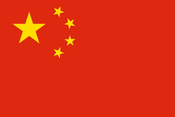
As America's power waned with the arrival of the 21st century, China found itself surpassing the US economy by 2025, beginning the Second Chinese Golden Age. China beat America in technology and space exploration, setting up the first lunar colonies on the moon and Mars.China became the leading military power, being the most up to date on technology, and thanks to conscription being placed, numbering over 200 million by 2055.
As the west fell further into decline, China managed to ride out the economic storm of the Second Great Depression.
As the smaller nations around it began to collapse, China took advantage and turned them into puppets and downright annexed them. In 2029, China turned Myanmar into a puppet state as it fell to the Hegemony's influence. Ten years later, the Chinese Hegemony invaded and annexed Mongolia, later morphing other states in Indochina into puppets.
Many nations protested China's actions, but similar to Nazi Germany and its annexation of the former Czechoslovakia, not doing such else besides demonstrating verbal distaste.
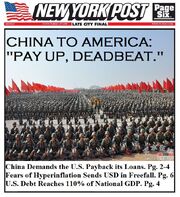
China poured trillions of dollars into the CFR and HIE to build the infrastructure of both nations in its bid to gain allies for the upcoming war it foresaw and actively planned for the arrival of. Together, China and its two allies signed the Pact of Hegemony, binding an airtight alliance. Along with that, China molded alliances with the emerging Latin American powers, mainly Brazil, Argentina, and Venezuela.
In 2053, the Chinese Hegemony invaded and conquered Thailand from their new positions in Cambodia and Laos.
In 2054, China demanded that Taiwan rejoin its great empire. The US, India, Korea, the Philippines, Vietnam, Australia and New Zealand formed a coalition intent on protecting Taiwan from Chinese imperialism. Tensions then hit their boiling point in the summer of 2055, when ships from each nation gathered in the Taiwan Strait.
The Spark (2055)[]
China set off the Spark that began the Third World War by invading Taiwan. The Allied fleet was decimated in the attack, and Taiwan fell within less than a week.
Days after the shocking Allied defeat, China turned on India, Vietnam and Korea. The latter two nations fell quickly, while India fanatically resisted, in spite of China and the HIE capturing New Delhi. The HIE and CFR were quick to join China in its war, calling themselves the Hegemony.
Battle of New Delhi (2055)[]
The HIE and China swarmed forces into India. Despite the natural barrier provided by the Himalayas, China managed to enter on Indian soil by invading through the vastly weaker Bhutan and Nepal, quickly annexing them in the process.
Together, the HIE and PRC took over New Delhi, India's capital by encircling the city in a wipe out attack.
Bangladesh was enticed to join the Hegemony, but years of falling under the Chinese sway caused it to be annexed by 2056, adding hundreds of millions of people and the most fertile land in the world to China.
Invasion of the Philippines (2055-2056)[]
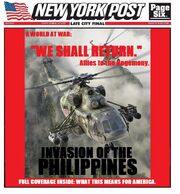
China, after conquering much of Asia, invaded the Philippines from the north with the assistance of the CFR. The northern islands fell quickly, as the Hegemony easily seized the capital of Manila; however, the Filipino military still resisted as best as they could, causing the Hegemony to become very bogged down battling in the region's thick jungles. Refusing to surrender, the Philippines held strong for a few more months, before Indonesia, Malaysia, and Brunei were persuaded to join the Hegemony.
Indonesia invaded from the south, and by the spring of 2056, the Philippines front collapsed, and the remaining islands surrendered, falling under joint Chinese-Indonesian occupation. The Filipinos, however, would continue fighting a guerilla warfare that the Chinese would not be able to put down.
Not long after, China, in a bid to distract the US, funded violent anti-war protests to cripple its domestic war effort.
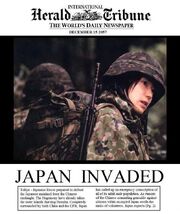
Battle of Japan (2057-2058)[]
Having wiped out most opposition in Asia, China saw neutral Japan as a threat to Chinese interests, and the next step in its bid for world supremacy. Japan, which had attempted to set positive relations with its Chinese neighbor, was completely thrown off guard by the attack, and forced to abandon Kyushu and Hokkaido, its most southern and most northern islands. Japan, fighting a completely superior enemy, could only delay its destruction.
Before the end of that year, Japan's free territory was diminished to a defensive circle around Tokyo. Seeing the campaign as hopeless, the US, Australia, New Zealand and Peru mustered whatever fleet it could spare for the evacuation of Japan; about 80 million Japanese soldiers and civilians were exited from the city, and shipped between the Allied nations, forming a government in exile. Japanese left behind, however, were brutally and efficiently killed.
For the first time in all of human history, Japan was successfully conquered by a foreign power, a move that only went on to further the Hegemony's confidence in what it believed to be a war to determine the fate of mankind.
Australia Campaign (2059-2060)[]

With only India left as the only significant Allied nation in Asia, China and Indonesia turned their attention to Oceania, launching an invasion of Australia, attacking from the north, then proceeding to advance south through the Outback. Australia and New Zealand only succeeded in destroying 1 of 4 invasion fleets, allowing landings to still take place. Australia resisted valiantly, even making an, at first, successful counter offensive that threw the Hegemony off guard for a moment. But ultimately, it was simply a minor set back, as the Hegemony pushed the Allies to Sydney, capturing it along with the capital of Canberra, which forced the Australian government to flee to Tasmania.
Meanwhile, a small contingent of Chinese shock troopers crushed New Zealand, leaving Australia alone in its fight; however, to China's annoyance, Australia refused to surrender, despite being reduced to two small pockets in the southwest and southeast.
Battle of Hawaii (2060)[]

Hawaii Falls
Regardless of India and Australia still providing a thorn in the side of the Hegemony, China went ahead with its plans for America, and pushed eastward, capturing Hawaii in a short but bloody battle. As the US had most its navy destroyed in the Battle of Taiwan, Hawaii buckled in a matter of weeks.
Hawaii would become an important base for China, being used as a shooting off point for China's invasion of the United States later that year.
The Latin Ultimatum (2060)[]
China, in a bid for more allies, went to the neutral nations of Latin America, meeting up with all of them at the Panama Conference in Panama City. The Leader of the People's Liberation Army himself, General Hon, gave each nations an ultimatum, telling to pick a side or be annihilated.
Brazil and Argentina were the first to join the Hegemony, while Colombia, Cuba, Chile and Ecuador joined on the side of Peru (Allied Powers). China was quick to woo other nations, like Venezuela, convincing them to join the Hegemony as well. Mexico, though given tempting offers, ultimately decided to keep its neutrality due to its close relations with the United States.
Regardless, Latin America was now at war, and the objective of the mission was complete; put the Latin world in anarchy to make China's conquest future easily.
Operation Dragon's Fire / Operation Golden Dragon (2060-2061)[]

Raging Rockies
China suddenly attacked the US mainland via the detonation of many nuclear weapons on American soil, in the process, destroying 29 US, including the capital, Washington DC; 100 million Americans (20% of the population), died in the attack. The US, of course, responded with its own attack, but the damage was limited, because China anticipated the counterattack by evacuating all its major cities, and setting up a well built nuclear weapons defense that spared many cities from being struck, including its capital of Beijing; only 75 million were killed in this attack.
Only hours after the nuclear exchange, China ordered tens of millions of troops stationed in Hawaii to begin shipping to the US mainland, predicting that the US would not dare strike its own soil, even if it was under the occupation of a foreign government. Chinese forces then were landed in the remains of Los Angeles, San Francisco and Seattle, while its CFR ally landed in the Juneau and Anchorage.
The invasion took America completely by surprise, and with most of its forces engaged in other Allied nations, the US army could only watch as China cut off its access to the west coast.
China, in a huge miscalculation, didn't account for the nuclear fallout and how it would affect Mexico, as millions of people died from radiation poisoning after China so haphazardly dropped its nukes on the US.
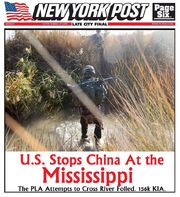
Mississippi Holds
The US pulled together a defense along the Rocky Mountains, holding it together for a few weeks, before the Hegemony managed a breakthrough, as the defense was horribly rushed, and the soldiers fell to radiation sickness, equipment shortages and attrition.
China quickly advance through the Great Plains, but was stopped at the Mississippi River during the Battle of Memphis, as the Chinese were unable to cross into the city.
So instead, China focused its efforts southward, looking at Texas. The state fell to many Hegemony casualties, before the advance south was halting by Mexican forces in Monterrey.
China expected to have the US at its knees within 5 months, only for the campaign, like the rest of the conflict, drag on and become the most bitterly contested war in all of human history, with both sides trapped in a deadlock across the Mississippi.
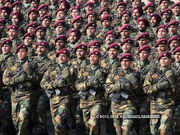
The Holi Offensive (2060)[]

India, seeing how China was incredibly distracted with its invasion of the US, seized on a massive opportunity to launch the war's largest counter offensive up until that point, catching the HIE and China off guard, resulting in the recapture of New Delhi, a move from India that provided a huge morale boost to the Allies in the face of one of its darkest hours.

Occupied America (2060-2065)[]

World War 3 (Occupied America)
China, in control of 2/3 of the US, quickly became plagued by guerrillas. To deal with it, China constructed thousands of death camps in occupied America, killing thousands of suspected rebels and "enemies of the state" every single day. But with bitter resistance internal and external, China agreed to Safety Order 2063: the systematic genocide of all those unfortunate enough to be living in China's occupied territories. Those that weren't killed, were placed into forced labor camps, and made as slaves, working to build the Hegemony's war effort; people who refused paid the ultimate price.
However, despite China's clear upper hand in the war, America refused to capitulate, becoming a fortress of ruins. It also did not take long to become entrenched as more and more men were thrown into the meat-grinder that was the Mississippi River.
Operation Roach's Nest (2062)[]

With no progress being done, China concocted a plan to secure America's surrender, going by the name "Operation Roach's Nest", an attack the new US capital of New York City, a risky gamble to take advantage of the US's weak eastern defenses. In spite of New York's isolation from the war, the Hegemony managed to pull off a surprise attack on the city and capture it in a few days.
The US was forced into organizing another river defense, this time at the Hudson, barely holding off China, and once again unable to cross, as New York became a fortress of broken glass.
America, on the verge of collapse, was forced to move its capital again, this time to Philadelphia, and there President Sloan was overthrown in a coup by the US military, and executed for incompetence. China's bid, while damaging, only made American resistance more fanatical and determined, as now the US military was in direct control of the nation.
For the next two years, the US would be fighting a war on its homeland with China on two fronts, with two identical defensive lines. Estimated casualties reached the hundreds of thousands nearly everyday, with both sides stubbornly holding their land, not caring about the cost of human life. Operation Roach's Nest was only a minor success.
Third Battle of New Delhi (2062)[]
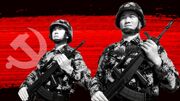
With India struggling to hold New Delhi, and slowly starting to break because of war, China and the HIE saw a perfect opportunity to take back the strategically important capital of India as a symbolic gesture of the Hegemony's invincibility and might. They launched a massive offensive that, after months of heavy fighting and fatalities, lead to the eventual recapture of the great city, causing Allied morale to fall lower than it ever had before, and allowing the Hegemony to reach a never before seen height, now controlling over 80% of the world. China alone controlled an empire spanning from the Arabian Sea to the Gulf of Mexico, something that was impressive but had no chance of lasting very long.
Turning of the Tides[]
Liberation of New York (2064)[]

Destroyed New York
Not long after hitting its height, the Hegemony quickly spread itself out to a breaking point, as Brazil fell into a civil war not long after, and many other Hegemony members found themselves having a more difficult time holding their territories.
In search for some kind of victory, the US launched several attacks on the city, each one more desperate than the last. It was on the 7th bloody attempt that the US finally broke through and after much violent close quarters urban fighting, retook the city, making New York the first territory to be liberated from the Hegemony. The liberation increased low US morale, and made liberating the rest of North America not seem so impossible. Meanwhile, China lost millions of troops spreading itself thin all for what was in the end little reward.
The Great Jihad (2064)[]
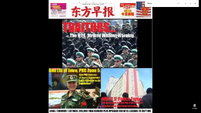
On December 1, 2064, the Hegemony broke apart, as the Holy Islamic Empire suddenly betrayed its allies, declaring a holy war on the godless CFR and China. With China losing a vital ally, and seeing the Indian front fall into chaos, the US saw the perfect situation, and it didn't take long for it to take full advantage. Before the end of that year, the US launched a massive offensive, allowing 30 million troops to cross the Mississippi. To assist America's offensive, India launched counter attacks of its own. China's war was falling apart; its bid to dominate the world, less than a decade into the war, was already collapsing in on itself.
Liberation of North America (2064-2065)[]
Within the span of 11 months, China was driven out of North America. In March of 2065, the Allies defeated China at the Battle of Corpus Christi, reestablishing the border between the US and Mexico. Not long after, the Allies made it to the Rockies, where they attempted to organize a defense, and win the war through attrition. The CFR, however, didn't feel as adamant as China did, abandoning all its gains in America not long after the victory in Texas, deciding to divert its attention to repelling the HIE invasion.

World War 3 (Liberating North America)
In the massive retreat to the Rocky Mountains, China destroyed everything it could, utilizing scorched Earth policy and killing as many as possible in occupied America. In fact, on December 31, 2064, the PLA camps were ordered to execute everybody being held prisoner, killing 15 million people in one day; the act of barbarism was infamously called "The New Year's Eve Massacre".
Chinese forces tried to make one last counter offensive at the Rocky Mountains, but were decimated at the Battle of the Ruins, losing Denver, Colorado, and suffering irreplaceable casualties.
In November of 2065, PLA presence in America was reduced to two small pockets, LA and Seattle surrendered after two separate but equally bloody battles. China's gamble to conquer America had failed, but the country was still left in ruins.
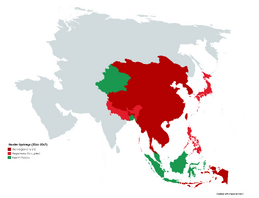
Hegemony in Southeast Asia in 2066
Muslim Uprisings (2066-2067)[]
For most of the Jihad, China would shift focus from its losses in America, so it could maintain the land it still control in Asia and Oceania, as well as holding onto the US state of Hawaii, which was still in PRC hands.
Being as isolated as it was from the Holy Islamic Empire, China, unlike the CFR, was safe from direct invasion. However, that didn't stop it from hurting the PRC in a different way. In 2066, the Godking (HIE's leader) called upon Muslims living in Indonesia and China's Xinjiang and Bangladesh autonomous regions to take arms and revolt against their Pro-Hegemony, Atheist-dominated leaders. It worked and China found itself suppressing revolts in Indonesia and its own territory left and right.
Jihadist Muslims in Cambodia, Malaysia and Bangladesh were crushed immediately, but Indonesia and Xinjiang were harder to quash due to natural barriers.
The revolts also managed to hinder the war effort in Australia. China was forced to pull soldiers from the Australian front to crush the Muslim rebels, launching a joint Indonesian-Chinese invasion of Indonesia's main islands. The last major rebel cell was wiped by 2067 in the Battle of Jakarta, where China was forced into using tactical nukes to raze the city. Not long after, China destroyed its own rebellion in Xinjiang. China, to prevent another uprising, went on a campaign of extermination, depopulating the territories.
China, around this point, signed a ceasefire with the Allies purely to focus on the HIE.
Operation Dragon Hunter (2067)[]
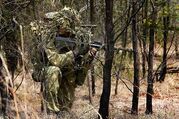
China and Indonesia, busy battling a rebellion in their at home, were taken advantage of by Australian and Free Kiwi forces in the south of Australia; blowing past defenses, the Allies ran into little Outback resistance. However, they did find themselves bogged down attempting to take back the eastern coast; the Hegemony still held Sydney and Canberra.
Within weeks, Australia managed to retake Darwin and the northern coast, stumbling upon an armada of abandoned Hegemony ships. Operation Dragon Hunter then ended with the Second Battle of Sydney. Remaining Hegemony forces fled to New Zealand, the last significant Hegemony stronghold in Oceania.

Operation Weeping Willow
The Plague Years (2067-2070)[]
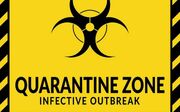
When the war turned against the HIE, in one desperate attempt, the Godking authorized the release of its last resort super weapon, the HAVA Virus, or Green Death. China was one of the worst affected by the outbreak, losing hundreds of millions over the course of 2 years. The Chinese government nearly collapsed from it, but still held strong.
When it was discovered that the virus incubated in trees, China was one of the first nations to begin scorched earth protocol, enacting Operation Weeping Willow. It lost the majority of its forests in that same time-span.
When the Green Death was finally exterminated by 2070, China renewed the war with the HIE by assisting the CFR in its invasion of the Middle East.

Operation Waltzing Matilda
Fall of the Hegemony (2071-2077)[]
Almost immediately after the HIE's capitulation, the Allies and Hegemony ended their ceasefire by mid-2071, with the Allies invading the tattered and crumbling CFR. By 2072, the CFR collapsed under the pressure of having Moscow seized from it, leaving only China and Indonesia as the remaining important Hegemony members. Following the fall of the CFR, the Allies began an island-hopping-campaign called Operation Waltzing Matilda. New Zealand and Hawaii were the first islands liberated from Chinese control in two very brief battles.

Operation Tempest
Indonesia was invaded from Australia, and very soon, the nation, if it could have even been called that by the 2070's, surrendered. Years of Chinese occupation and genocide left most of the nation's people buried in mass graves, leaving it a country in name only. But by that point in the war, long after both sides had committed horrible atrocities, nobody was in shocked; the world was simply desensitized to acts of genocide. Indonesia was occupied and China found itself even more vulnerable than it already was to attack from the south.
In 2074, the Allies attacked and liberated the Philippines a few days after landing troops in Manila; this began Operation Tempest, the bombings of Taiwan, Japan and the Chinese coast, where hundreds of tons of explosive material was dropped on those territories daily.
In 2075, India broke through the Himalayas and made an offensive into Tibet, suffering extensive casualties, but still still being the first power to touch down on and secure territory on the Chinese mainland.

Battle of Xian
In 2076, Free Japanese forces were landed in southern Japan, quickly liberating the islands, as China pulled most of its troops out for the sake of protecting the mainland, which had become the PLA's number one priority. The Second Battle of Taiwan was barely a battle at all, as China's territorial gain that began the entire war fell back into rightful Allied hands. The Allies then spent nearly a year assembling the invasion force suitable to take on the People's Liberation Army.

Operation Scorched Garden
Early-2077: Operation Scorched Garden began with a massive Allied fleet sailing across the Taiwan and Korean straits. Millions of soldiers were lost on the battle's first day. Regardless, Beijing fell after an intense battle, and China was cut off from the ocean.
General Hon, still leading the PLA, rallied his army one last stand in Xi'an. After much bloody urban warfare that left the city reduced to rubble and nearly five million dead, the PLA collapsed, and Hon was killed in action. The remaining Chinese government called for a full scale surrender, signing the Treaty of Jerusalem on October 4 of that year. The war began and ended with China's aggression and China's fall and capitulation.